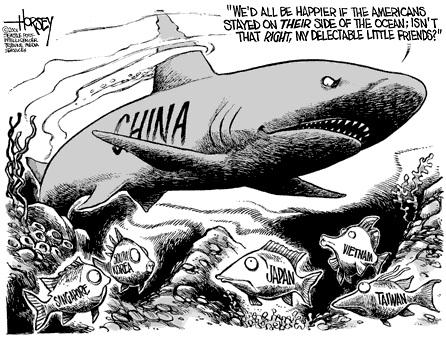Dollar-Yuan – When the dust settles

Originally published on Wednesday, May 09, 2001 - Cartoon David Horsey; Seattle PI
EU’s trade deficit
The interesting point is how EU manages its trade deficit – without blaming China-Yuan. EU-zone countries like Greece, Ireland, Italy, Portugal, Spain, are on the verge of a sovereign default. Euro-zone is upto its gills in debt. The Euro is being called names. And EU is not snivelling about the yuan and China?
Very un-European!
Usually…

USA, EU Trade Balance with Oil Producers (Graphic source and courtesy - http://www.eurotrib.com). Click for larger image.
Europe is at the forefront seeing dangers, damage, affronts, threats, effects, fall-outs et al. The whole she-bang! But in case of China and Yuan, Europe is not doing much of crying about the ‘undervalued’ Yuan. The Euro revaluation is a recent affair. So, not of much consequence. The Yuan undervaluation has been on the US agenda for a few years now – with varying intensities. Euro-trade balance with China is slightly in China’s favour. All in all, good management by the Euro-zone, it appears.
Which in the current scenario is the one-bright-spot on the Euro-horizon!
Good for them.
The US Treasury has been charged by Congress to assess whether China is a ‘currency manipulator’ … the very concept of currency manipulation is flawed: all governments take actions that directly or indirectly affect the exchange rate. Reckless budget deficits can lead to a weak currency ; so can low interest rates. Until the recent crisis in Greece, the US benefited from a weak dollar-euro exchange rate. Should Europeans have accused the US of ‘manipulating’ the exchange rate to expand exports at its expense?
Although US politicians focus on the bilateral trade deficit with China — which is persistently large — what matters is the multilateral balance. When demands for China to adjust its exchange rate began during George W Bush’s administration, its multilateral trade surplus was small. More recently, however, China has been running a large multilateral surplus as well.
Saudi Arabia also has a bilateral and multilateral surplus: Americans want its oil, and Saudis want fewer US products . Even in absolute value, Saudi Arabia’s multilateral merchandise surplus of $212 billion in 2008 dwarfs China’s $175 billion surplus; as a percentage of GDP, Saudi Arabia’s current-account surplus, at 11.5% of GDP, is more than twice that of China. Saudi Arabia’s surplus would be far higher were it not for US armaments exports.
In a global economy with deficient aggregate demand, current-account surpluses are a problem. But China’s current-account surplus is actually less than the combined figure for Japan and Germany; as a percentage of GDP, it is 5%, compared to Germany’s 5.2%.
Adjustment in the exchange rate is likely to shift to where the US buys its textiles and apparel: from Bangladesh or Sri Lanka, rather than China . Meanwhile, a rise in the exchange rate is likely to contribute to inequality in China, as its poor farmers face increasing competition from the US’ highly subsidised farms. This is the real trade distortion in the global economy, one in which millions of poor people in developing countries are hurt as the US helps some of the world’s richest farmers.
Since China’s multilateral surplus is the economic issue and many countries are concerned about it, the US should seek a multilateral, rules-based solution … Unfortunately, this global crisis was made in the US, and the country must look inward … (via No time for trade war between US and China: Joseph E Stiglitz-International Business-News-The Economic Times).
US trade deficit
Stiglitz, in the post linked above, does a good job in demolishing American propaganda against the Chinese yuan. He shows how while there is case for yuan revaluation, the logic is not what the Americans are giving.
To de-fang American pressure, China recently reported a trade deficit. Much like Europe, Japan, Asian Tigers had to recalibrate their currencies, China too will have to do it. Dollar gyrations are sinking many smaller economies – like the cartoon above from Sri Lanka represents.
The mystery of the forex basket
Increasing the share of Euro in global forex reserves is a long-term EU objective. Is this European quiet related to:-
1. Keeping China happy,
2. Pushing the Euro proposition to the Chinese
3. Increasing the share of Euro in China’s reserves basket.
4. All at the dollar’s expense.
5. After all, who would like to turn away a creditor who is happy with low-to-zero interest with an excess of US$2.5 trillion sloshing around.
6. This US$2.5 trillion can turn Euro-fortunes!
USCAP
.jpg)
Mad Pakistani Tiger eating itself! (Cartoon from Korea Times).
The US has successfully executed US-Client-Acquisition-Programme (USCAP) – a most out-sized ‘conquest’ in history. By using economic levers, it has successfully created client-states across Europe, SE Asia, Japan, China, etc. Some economies have taken the bait, used US incentives and become ‘successful’ client states.
What is most intriguing is Stiglitz’s choice for US largesse – after China. Sri Lanka or Bangladesh, he says. With Pakistan, Sri Lanka and Bangladesh as US clients, India’s may see itself encircled by Anglo-Saxon client states.
A declining West, riding away into the sunset, somehow seems unreal to me.
Related articles
- China Sets Yuan Rate at New High (newser.com)
- Yuan Hits Trading Band Limit Again – WSJ.com (mbcalyn.wordpress.com)






 Exciting new series. From 1 Mar, 2010.
Exciting new series. From 1 Mar, 2010.
https://twitter.com/Marut_/status/205219847221673985